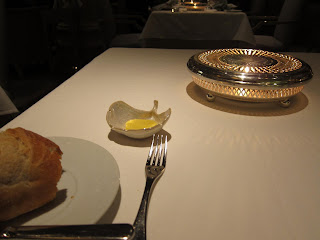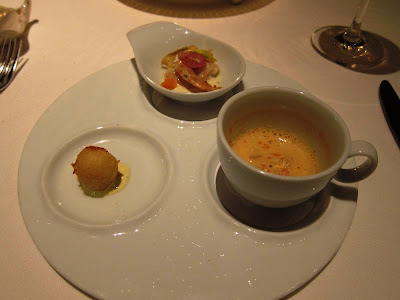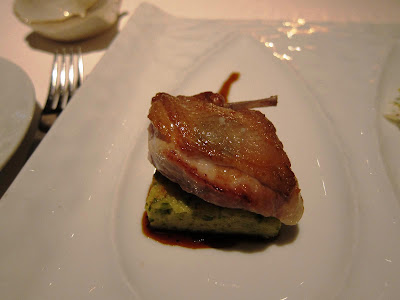Haute in California - Part I
 I sat back swirling the honeyed richness of a sip of Riesling in my mouth and admired the opulent interiors of Micheal Mina. As I watched the army of waitstaff go about in quiet efficiency, I contemplated on the storied journey of haute cuisine.
I sat back swirling the honeyed richness of a sip of Riesling in my mouth and admired the opulent interiors of Micheal Mina. As I watched the army of waitstaff go about in quiet efficiency, I contemplated on the storied journey of haute cuisine.
France is widely credited for the elevating Western cuisine into a sophisticated, multi-sensory form of indulgence with its complex sauces, artful presentation and well-defined courses. But all that did not happen over a day. During the medieval times, feasts were common among the high and mighty. Multiple courses of food were prepared but always served together. Eating with bare hands were the norm then. These banquets always ended with a selection of desserts, cheese and spiced wines. Towards the later years, royal cooks such as Taillevent became celebrities and wrote influencial cookbooks. I was brought back to the present as the first course of my dinner arrived. I had chosen the three-course prix fixe menu that employs Mina's famous 'trio' concept and includes dishes that have become classics at this restaurant over the years. The trio of Wolfe Ranch quail in front of me looked exquisite! The first preparation was a herb-roasted breast with poached prune and sauce perigourdin, the second a leg confit jombonnette with pomegranate aioli and frisse salad, and the third was seared foie gras with persimmo coulis and pistachio butter. The variation of texture and taste from the crispness of the breast to the soft fleshy confit and finally the soft decadence of foie gras made for an amazing start.
I was brought back to the present as the first course of my dinner arrived. I had chosen the three-course prix fixe menu that employs Mina's famous 'trio' concept and includes dishes that have become classics at this restaurant over the years. The trio of Wolfe Ranch quail in front of me looked exquisite! The first preparation was a herb-roasted breast with poached prune and sauce perigourdin, the second a leg confit jombonnette with pomegranate aioli and frisse salad, and the third was seared foie gras with persimmo coulis and pistachio butter. The variation of texture and taste from the crispness of the breast to the soft fleshy confit and finally the soft decadence of foie gras made for an amazing start.

 France's famous haute cuisine took roots during the 17th century. This was a time when the guilds had evolved: a system that regulated the food industry and forced specialization among food vendors and establishments. You could now be a butcher, a grocer or a baker but had to stick to only one thing. This was also the time when French cuisine began changing dramatically. Heavy and exotic spices from distant places were passe. They were replaced by natural flavors and local herbs. Cooks began focusing on enhancing the taste and flavor of meat and vegetables instead of masking them; freshness of the key ingredients attained primacy during this time.
France's famous haute cuisine took roots during the 17th century. This was a time when the guilds had evolved: a system that regulated the food industry and forced specialization among food vendors and establishments. You could now be a butcher, a grocer or a baker but had to stick to only one thing. This was also the time when French cuisine began changing dramatically. Heavy and exotic spices from distant places were passe. They were replaced by natural flavors and local herbs. Cooks began focusing on enhancing the taste and flavor of meat and vegetables instead of masking them; freshness of the key ingredients attained primacy during this time.
My second course was in front of me now: the Trio of Fatty Pigs. A Tenderloin with shnitzel and spatzle that reminded me of Austria, a Short Rib with braised cabbage and poached quince, and Braised Shoulder with potato rosti and apple mustard. The pork was a medley of tastes and textures. Very exciting, especially the crisply braised shoulder! Also very filling with all that meat and thick sauces. It was only in the late 19th century that haute cuisine in France became organized into its currently recognizable form. Escoffier who was a central culinary figure during this time is acknowledged as the man behind modern restaurant kitchens of the West. He divided the kitchen into five stations: one each for the cold dishes, the starches and vegetables, the sauces, the roasts, and the desserts. Cooking beame team-work even when preparing a single dish. The great hotels that were built during this time over Europe and America became home for chefs that were eager to please discerning modern palates. Americans took time to embrace French cooking. During the colonial days, Americans had a distinct disdain for French cooking techniques and that continued for some time.
It was only in the late 19th century that haute cuisine in France became organized into its currently recognizable form. Escoffier who was a central culinary figure during this time is acknowledged as the man behind modern restaurant kitchens of the West. He divided the kitchen into five stations: one each for the cold dishes, the starches and vegetables, the sauces, the roasts, and the desserts. Cooking beame team-work even when preparing a single dish. The great hotels that were built during this time over Europe and America became home for chefs that were eager to please discerning modern palates. Americans took time to embrace French cooking. During the colonial days, Americans had a distinct disdain for French cooking techniques and that continued for some time. Course Three tonight was pastry chef Catherine Schimenti's Dessert Trio: Buttermilk panna cotta with lemon, huckleberry-ginger ice-cream, Chocolate mousse cake with salted caramel and mascarpone, and Squash cheesecake with rosemary and honey pine-nut. The panna cotta and the cheesecake were particularly delightful!
Course Three tonight was pastry chef Catherine Schimenti's Dessert Trio: Buttermilk panna cotta with lemon, huckleberry-ginger ice-cream, Chocolate mousse cake with salted caramel and mascarpone, and Squash cheesecake with rosemary and honey pine-nut. The panna cotta and the cheesecake were particularly delightful! I must also mention the amuse bouches at Michael Mina tonight: a trio of seafood delicacies that included a gazpacho, a shrimp salad and was followed by an excellent Hearts of Palm Salad that had a nice and tangy taste of grapefruit. Hopefully, Michael Mina will continue to delight in spite of a recent setback - losing one star in the recently published 2010 Michelin Guide.
I must also mention the amuse bouches at Michael Mina tonight: a trio of seafood delicacies that included a gazpacho, a shrimp salad and was followed by an excellent Hearts of Palm Salad that had a nice and tangy taste of grapefruit. Hopefully, Michael Mina will continue to delight in spite of a recent setback - losing one star in the recently published 2010 Michelin Guide. As French haute cuisine made its way across the Atlantic to the New World, French cooking itself underwent change during the 20th century. War and Portuguese immigrants brought in new ingredients and new flavors. Nouvelle - new - cuisine came into being with simpler sauces and increased emphasis on presentation. Back the USA, the popularity of Julia Child's books and television shows finally brought what was once the cuisine of aristocracy to everyday Joe's dining table.
As French haute cuisine made its way across the Atlantic to the New World, French cooking itself underwent change during the 20th century. War and Portuguese immigrants brought in new ingredients and new flavors. Nouvelle - new - cuisine came into being with simpler sauces and increased emphasis on presentation. Back the USA, the popularity of Julia Child's books and television shows finally brought what was once the cuisine of aristocracy to everyday Joe's dining table.
Coming next in this series: New American Cuisine and Luce in San Francisco.


4 comments:
the write up was almost like a page from a novel .. I think you need to start writing a book :)
Lovely as usual!!
lovely, I like the way you blended the history of haute cuisine with the food you were having.
Taking inspiration from you, I wrote my first food post.
@Deepti: Thanks! Appreciate it.
@Vamsee: Have to check out your post too. I know I have been a laggard.
Post a Comment